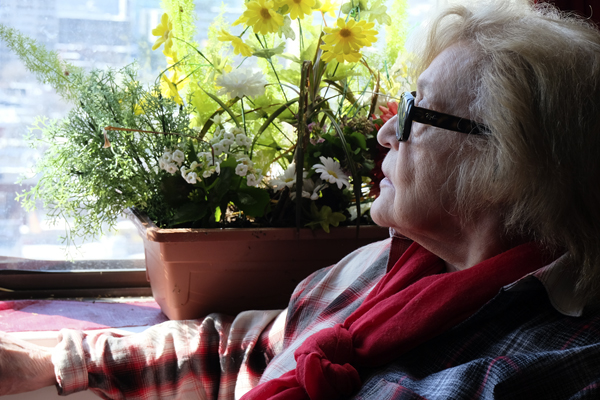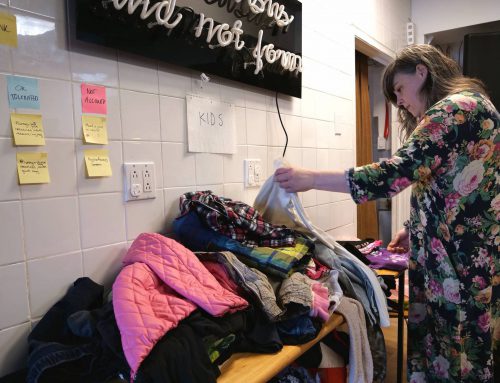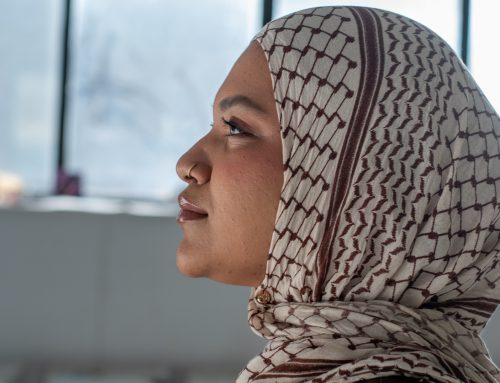BY Fiona Harrison-Roberts & Lyes Mahouche
Denise Robertson walks with a slight limp towards her living room before taking a seat on her couch. Robertson, a retired journalist, lives alone in a one-bedroom apartment with her two cats, Myoko and DJ.
On the walls of the cozy apartment, there are paintings and ornaments from her travels. Yet, despite the vibrant decorations and her cheerful demeanour, there is a sense of emptiness in the air. Robinson’s reason for moving back to Montreal was so she could spend time with her three grandchildren, but now she finds herself alone.
Robinson suffers from fibromyalgia which takes a toll on her body. “Just getting out of bed in the morning is a challenge,” she says. She now receives assistance from community group volunteers.
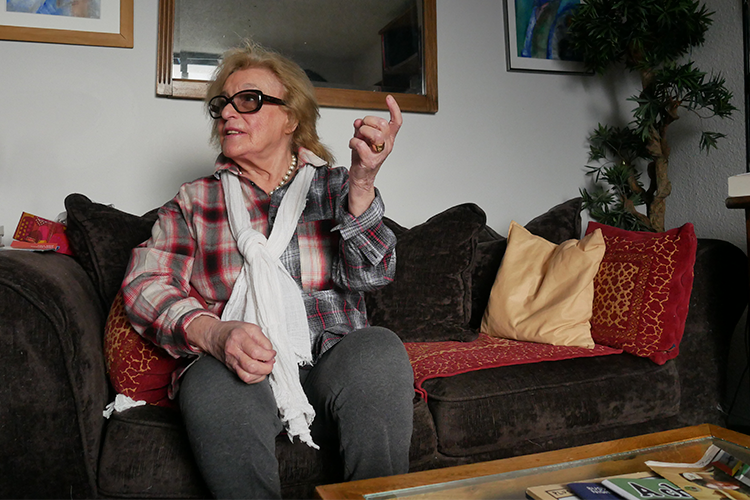
“Le bel âge as they say, I don’t know what’s beau about it. Also not being well, it’s very difficult, but I’m very positive. I think intellectually I’m still okay, and I’m fighting to get something to get my mind off it, because otherwise you can’t get up. You just stay, lie down and complain: why me, why? You’ll never get an answer, so what’s the point? Might as well forget it. It’s not an easy job”. Photo by Lyes Mahouche.
There are many initiatives to combat senior isolation in the city including the Yellow Door’s Friendly Calls program.
“Two other volunteers and I spend time calling elderly members of our community that we know are particularly isolated due to illness, family circumstances, or mobility, and those who have been flagged for having mental health issues,” says Trina Sanchez. “We say 15 minutes, but some want six minutes and others want an hour.”
A map of senior community centres in Montreal. Information retrieved from Contactivity Centre and AMI-Quebec AMI-Quebec. Map by Fiona Harrison-Roberts.
While initiatives like the Friendly Call program help, there seems to be a lack of city-wide planning for senior care. According to Santé Montreal, Montreal’s senior population is expected to rise to 465,800 by 2036. That’s up from 323,660 in 2016.
A lack of services leaves seniors more vulnerable to being isolated. A study conducted by the government of Canada found that social isolation of seniors is most common for those who lack access to transportation, or who may suffer from a disability or chronic illness.
When Robinson arrived in the city, Santé Montréal’s Local Community Service Centres (CLSC) was able to outfit her bathroom with the necessary accessibility items to ensure she was able to live with ease in her one-bedroom apartment.
However, she quickly learned about the issues that plague Quebec’s health care system. Robertson has been without a family doctor for three years.
On Christmas Eve, last year, an injury left her isolated and alone on Christmas.
“I went downstairs to do last minute shopping,” says Robertson. She decided to use the service elevator. “I opened the door, and I did not realize that it was not on the same level. I pushed my walker and the weight of the walker pushed me down. I fell down, not by very much, but I was black and blue.”
Instead of going to an emergency room that would be packed with other patients waiting to be seen by a doctor, Robertson called the CLSC.
“No one could help me,” says Robertson. “I called the CLSC and said, ‘Can a nurse come?’ At least she could diagnose me if I have a fracture or if it’s just bruises that will disappear, and she said, ‘I’m afraid we’re too busy, we don’t have any nurses available, so I’ll pass you along to a nurse on the telephone.’”
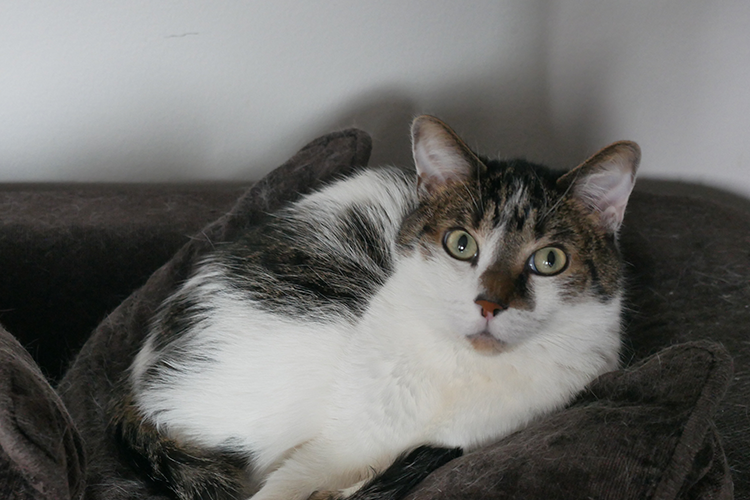
Myoko, Denise Robertson’s cat rests on the couch near her. “They are the most supportive, I can’t say people, but the company I have in Montreal,” she says speaking of Myoko and her other cat DJ. Photo by Lyes Mahouche.
From there, a nurse led Robertson through a self-diagnoses, which revealed that she had broken her ribs. Though, no one ever visited to check on her.
Meghan Joy is an associate professor of political science researching how municipal governments make age-friendly policies. She says that the senior population is sometimes forgotten when it comes to legislation or services.
“There is a tendency to see all seniors as very privileged,” she says. “A homogenous understanding around this generation, which just isn’t true.”
Joy believes that Montreal could learn a lesson from Toronto when it comes to senior strategy.
“(Toronto) had a large consultation translated into at least 14 languages to ensure that different populations’ views were taken into account,” says Joy. “Whereas in Montreal, it wasn’t even printed in English, and we really had to push for that.”
Language barriers are another cause of senior isolation. According to AMI-Quebec, only 37.6 per cent of English-speaking seniors frequently felt as though they belonged in their communities, and less than half (43 per cent) of those surveyed belonged to a social club or organization.
The language barrier within Montreal is one of the factors that keep a portion of the senior population isolated if they are unable to communicate. In Quebec, 34 per cent of English speakers are immigrants.
Joy also notes that the way in which Toronto and Montreal municipalities function plays a large role in how senior plans are developed.
At non-profit organization The Yellow Door, youth engage with the elderly population. Video by Lyes Mahouche.
“The city of Montreal has a senior strategy, but a lot of the responsibility in terms of urban planning, local parks, local roads, and local community centres is actually [on] the boroughs-level of government,” says Joy. “The city of Montreal can’t actually force boroughs to have their own senior strategies.”
Alternatively, in Toronto, the power lies with city hall. For example, the city has the power to take care of long-term care for seniors.
“I think because Toronto has more responsibility, it maybe has more of the capacity to integrate some of these policy areas and try to figure out where the silos are,” says Joy.
However, she also notes that the borough system of Montreal creates mini municipalities that can cater to their specific population, for example through cultural centers. Thus there are more opportunities to personalize community services to seniors.
Robertson believes the city can make more of an effort to get seniors out to events and community gatherings around the city.
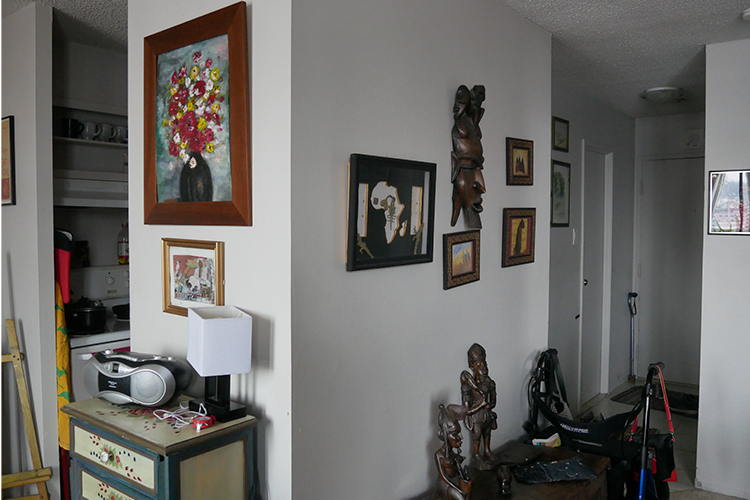
Mementos from Denise Robertson’s career as a journalist and press officer cover the walls of her apartment. Her job took her all around Africa and the Middle East. “I was just given a huge tape recorder, and I went on the street interviewing people. That’s how I got started as a journalist.” Photo by Lyes Mahouche.
“I know there’s a lot going on not far from here,” says Robertson, referring to the location of her apartment close to Mont-Royal. “Like Place-des-Arts, there’s loads of activities. What the city of Montreal can do, is every time they have an event, or a concert, have volunteers to get seniors and take them out.”
This was a point that was also highlighted by Joy. While it’s a small step, it could have great effects on the senior community.
“I can afford to go to a concert,” says Robertson. “But, I can’t afford to go alone.”
[slide-anything id=”3583″]
“What would make me very happy is to have a young Canadian take my idea, take my Pouch Cat. There’s a future in it. I’ve got the ideas, but I don’t have the legs anymore.” Pouch Cat is Robertson’s project which earned her three medals at the Concours Lépine in France. The flushable litter is made to be lighter, cleaner and more eco-friendly than regular litter. Photo by Lyes Mahouche.
“What would make me very happy is to have a young Canadian take my idea, take my Pouch Cat. There’s a future in it. I’ve got the ideas, but I don’t have the legs anymore.” Pouch Cat is Robertson’s project which earned her three medals at the Concours Lépine in France. The flushable litter is made to be lighter, cleaner and more eco-friendly than regular litter.
